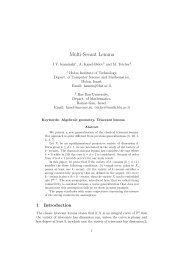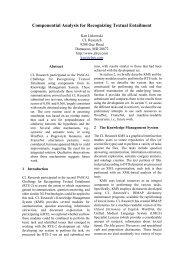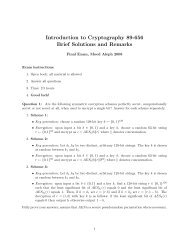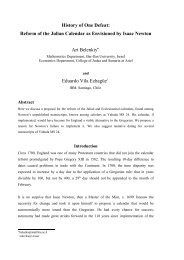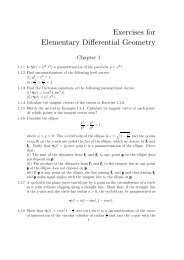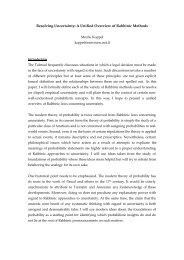COMPLEX FUNCTIONS Contents 1. Complex numbers, Cauchy ...
COMPLEX FUNCTIONS Contents 1. Complex numbers, Cauchy ...
COMPLEX FUNCTIONS Contents 1. Complex numbers, Cauchy ...
Create successful ePaper yourself
Turn your PDF publications into a flip-book with our unique Google optimized e-Paper software.
<strong>COMPLEX</strong> <strong>FUNCTIONS</strong> 5<br />
4. Trigonometry, harmonic function, types of integrals<br />
of complex function<br />
<strong>Complex</strong> trigonometric functions in terms of the complex exponential<br />
function.<br />
The Jacobian J f of a holomorphic function w = f(z) = u(x, y) +<br />
iv(x, y) of independent variable z = x + iy has the form<br />
)<br />
J f =<br />
( ∂u<br />
∂x<br />
∂v<br />
∂x<br />
∂u<br />
∂y<br />
∂v<br />
∂y<br />
which can be written in terms of the partials of u alone<br />
J f =<br />
( ∂u<br />
∂x<br />
∂u)<br />
∂y<br />
− ∂u<br />
∂y<br />
∂u<br />
∂x<br />
(4.1)<br />
(4.2)<br />
by exploiting the <strong>Cauchy</strong>-Riemann equations.<br />
The matrix J f is proportional to a rotation matrix. Namely, J f is<br />
multiplication by the complex scalar<br />
f ′ (z) = ∂u<br />
∂x + i∂v ∂x .<br />
Here u and v are both harmonic functions.<br />
Definition 4.<strong>1.</strong> Harmonic functions are functions in the kernel of the<br />
Laplace operator ∆ = ∂2<br />
+ ∂2<br />
.<br />
∂x 2 ∂y 2<br />
Real and imaginary parts of a holomorphic function are harmonic.<br />
Definition 4.2. The conjugate harmonic function.<br />
Example 4.3. The function log(x 2 + y 2 ) does not have a GLOBAL<br />
harmonic conjugate.<br />
Definition 4.4. integral of a complex function of a real variable.<br />
Definition 4.5. Integral of a complex function of a complex variable<br />
(a line integral).<br />
Properties of integrals, defined as Riemann sums. linear, additive,<br />
etc.<br />
Estimate above in terms of upper bound on function.<br />
Discussion of path −γ with the opposite orientation. Reversal of<br />
orientation changes the sign of the integral:<br />
∫<br />
∫<br />
f(z)dz = − f(z)dz.<br />
−γ<br />
γ





